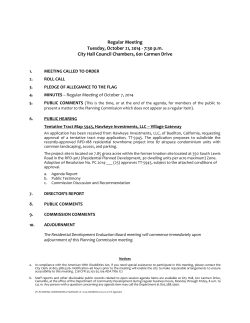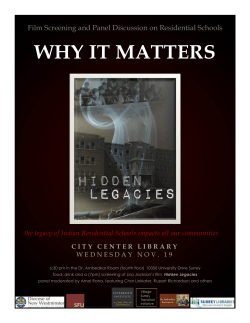
Peter Newton presentation from JCF lunch
Regenerating Australia’s Established Suburbs: Towards a New Greyfields Model of Development Presentation to: John Cain Foundation Lunch Graduate House, University of Melbourne Wednesday 6 May 2015 Professor Peter Newton Swinburne Institute for Social Research Metro [Melbourne] Challenges: • • • • • • • • • • • Melbourne’s current & forecast high population growth Housing supply lagging demand….increasing gap ; land supply issue Housing mix…..undersupply of medium density housing Housing affordability….capital city housing prices world leading……. Melbourne among least affordable globally High cost of delivering inner/middle suburban medium density housing Urban sprawl…greenfield continues to be where most new housing is built (negative externalities: economic, environmental, social) Suburbanisation of social and economic disadvantage (income, access to public transport, tertiary education, specialist health, concentration of social problems) Key urban infrastructures ageing and lagging development (especially public transport); Engineers Australia Report Card Developing new hybrid urban infrastructures for energy, water and waste Ecological footprint among highest globally (resource consumption + CO2) Plan Melbourne …. no comprehensive strategy for regenerative intensification in established, underperforming suburbs [Urban Infill ‘Report Card’] Liveability ≠ Sustainability: Melbourne’s Large Ecological Footprint • Melbourne’s ecological footprint (EF) twice that of highly liveable European cities and four times the world average [resource use + CO2 emissions] • Why? Underpinning built environment (planning, housing, transport ..) & urban lifestyle factors • Developing countries rapidly urbanising + EF of their cities increasing • Limits to growth / planetary boundaries tested/ exceeded under BAU city development Source: Newton (2012) • ► need for more sustainable –regenerative– urban retrofits Future Population Forecasts (ABS series B) Melbourne’s population forecast to double in 45 years Source: Chris Loader (chartingtransport.com) Housing market: constrained middle city housing supply increasing costs and suburbanising social disadvantage Source: SGS and Chris Loader (chartingtransport.com) Relative Advantage of Melbourne’s Established Middle Suburbs Access to public transport Access to jobs Access to tertiary education Source: SGS Untapped Potential: Melbourne’s Established Middle Suburbs The middle suburbs are persistently failing to meet their share of population and housing in a (rapidly) growing city. 3 Horizons of Urban Development Development Model ? X:NRZ, GRZ √ : BBC + √ : GAA + Greyfields are characterised by occupied residential areas that are physically and technologically obsolescent, environmentally poor performing and where the asset value resides in the land rather than the building (Newton, 2010; Built Environment ) Defining Greyfields >30% housing stock in established inner / middle suburbs represent “Greyfield” built environments: • physically, technologically and environmentally poor performing (but occupied) dwellings • economically under-capitalised/under-utilised asset • where > 80% total property value is vested in the land; indicating high redevelopment potential RDI= [land value/total property value] Boroondara Residential Properties Melbourne Residential Properties 18000 16000 16000 14000 14000 12000 12000 10000 Residential Properties in 2000 Properties Properties Residential Properties in 2000 10000 Residential Properties in 2006 8000 Residential Properties in 2006 8000 6000 6000 4000 4000 2000 2000 0 0 1.00 - 0.9 0.89 - 0.8 0.79 - 0.7 0.69 - 0.6 0.59 - 0.5 0.49 - 0.4 0.39 - 0.3 0.29 - 0.2 0.19 - 0.1 1.00 - 0.9 0.09 - 0.0 0.89 - 0.8 0.79 - 0.7 0.69 - 0.6 0.59 - 0.5 0.49 - 0.4 0.39 - 0.3 0.29 - 0.2 0.19 - 0.1 0.09 - 0.0 RDI RDI Stonnington Residential Properties Maroondah Residential Properties 8000 12000 7000 10000 6000 Residential Properties in 2000 8000 Residential Properties in 2006 5000 Properties Properties Residential Properties in 2000 4000 Residential Properties in 2006 6000 3000 4000 2000 2000 1000 0 0 1.00 - 0.9 0.89 - 0.8 0.79 - 0.7 0.69 - 0.6 0.59 - 0.5 0.49 - 0.4 RDI 0.39 - 0.3 0.29 - 0.2 0.19 - 0.1 0.09 - 0.0 1.00 - 0.9 0.89 - 0.8 0.79 - 0.7 0.69 - 0.6 0.59 - 0.5 0.49 - 0.4 RDI 0.39 - 0.3 0.29 - 0.2 0.19 - 0.1 0.09 - 0.0 Stages in the housing life cycle of a metropolitan region Source: Newton et al 2011 Models for Greyfield Infill Development (1) Activity Centres and (2) Transport Corridors are both necessary but not sufficient instruments for meeting infill targets and delivering more compact cities. They are not acting as the ‘twin magnets’ planning policy has articulated. (3) Piecemeal infill: Most residential redevelopment occuring OUTSIDE current designated development zones … as fragmented, sub-optimal ‘knock-down-rebuild’ Currently there is no operational model for medium density residential precinct redevelopment in the Greyfields [ in Neighbourhood and General Residential Zones] What’s happening with urban infill in Melbourne? : a Report Card • Urban Infill is an objective of Plan Melbourne, BUT net new housing infill below 50% • Brownfields (BF): Greyfields (GF) ratio of new dwelling construction running approximately 45:55 ……need for a publically accessible audit of Melbourne’s BF • Types and scale (YIELD) of dwelling projects vary significantly between BF & GF: Greyfields: ►27% 1:1 50% 1:2-4 units Brownfields: 17% 1:50-100 56% 1: 100+ units • Public transport access level (PTAL ) is not a magnet for attracting higher levels of infill; households remain attached to cars and developers to offering car parking • CBD is only Activity Centre attracting significant rate of new housing development • Type of infill housing varies by area socio-economic status: Above ave. SES locations: 1:1 replacement; high rise apartments dominate Average-to-Below ave. SES locations: 1: 2-4 and 1: 5-9 projects dominate ►Slow burn with piecemeal infill development: creeping loss of green space (UHI); Where is the medium scale residential precinct development? Medium density precinct scale redevelopment significantly under-represented in urban infill projects in greyfields and brownfields Residential infill yields of Projects, Melbourne, 2004-2010 (% total infil) 1 2-4 5-9 10-19 20-49 50-99 100+ Total 1.3 0.5 0.7 2.8 4.1 5.9 19.2 34.4 Greyfield 17.9 32.3 6.3 2.3 3.2 2.3 1.3 65.6 Totals (%) 19.2 32.8 7.0 5.1 7.3 8.2 20.5 100.0 21,947 37,614 8,029 5,833 8,309 9,374 23,487 114,593 Brownfield (N) Source: Newton & Glackin (2014; UP&R) Why Precincts? Precincts offer the prospect for more innovative regenerative (re-)design of more sustainable, resilient, low carbon neighbourhoods: •Housing (variety, affordability, yield) •Energy (low/zero carbon; distributed generation eg.PV + storage) •Water (integrated stormwater/ rainwater/ greywater for non-potable re-use; water sensitive design) •Waste (optimise recycling, reuse, food composting) •Mobility and health (more walkable, cyclable) •Neighbour contact (community places, spaces, gardens) → creates a dividend additional to housing yield Several tools now exist for precinct design performance assessment: Green Star Communities (GBCA); PrecinX (Kinesis); EnviroDeveloper (UDIA); SSIM (AECOM); IRM (ARUP); LESS (Hassell); OnePlanetCommunities (BioRegional Aust.) Innovation Arenas for Initiating Greyfield Precinct Regeneration Source: Newton et al 2011 Where: ENVISION Tool Set parameters for spatial queries: Select: ‘Market option’ or ‘Planning option’ ENVISION will be accessible from August 2015 on AURIN e-Research portal What? 3D Precinct Sketch Design Visualisation & Precinct Assessment: ESP Source: Monash Architecture ESP tool: rapid environmental performance assessment of innovative sketch designs of low-to-mid rise housing typologies envisaged for a greyfield residential precinct → permits calculation of potential environmental and financial DIVIDEND from project How? Alternative models for financing greyfield precinct redevelopment Alternative pathways for neighbouring landowners to participate in Greyfields precinct redevelopment process ENVISION Financial Feasibility Assessment Module How? Engaging property owners: proposition, development options Boisdale St. Redevelopment Project…….the thorny issue of neighbourhood character VCAT was not opposed to the scale of the development, but rather was focused on the development’s response to neighbourhood character (J and C Australia Unit Trust v Whitehorse CC [2009] VCAT 2759 Appeals to VCAT, 2007–2012, by municipal council area, Melbourne: can planning be better than this…… Source: Newton & Glackin (2014) Cantankerous cities: intensification, neighbourhood change and resident reaction Game of Zones ? ……Lifters and Leaners? Locking up opportunities for urban regeneration? New Zoning system introduced July 2014: NRZ - Neighbourhood Residential Zone: ‘single dwellings and some dual occupancies’ GRZ - General Residential Zone: ‘single dwellings and some medium density’ RGZ - Residential Growth Zone: ‘mixture of townhouses and apartment with u/g parking’ How to progress? Residential Growth Zone limited…..significant residential redevelopment potential in BOTH General and Neighbourhood Residential Zones Municipal Housing Strategy process as catalyst for exploring precinct/ neighbourhood change/ regeneration opportunities Scope for identifying prospective locations for ‘Regen’ [Greyfield Regeneration] Overlays designed to support medium density precinct residential development projects: Regen overlays require clear specification of the design & performance features required for any precinct development proposal Redevelopment of Greyfield public housing stock as catalyst for neighbourhood regeneration • 23,000 public housing allotments In Melbourne • Much of the stock ageing and poor quality • Owned by single entity (state government) Business-as-usual redevelopment of a public housing allotment: ( $5.6B Social Housing Initiative enabled some innovation, but restricted to small parcels and not extending beyond state-owned property) Source: AHURI (Monash and Swinburne), 2015 Greyfield public housing stock as catalyst for neighbourhood regeneration: PRECINCT Model Multiple benefits (dividend) deriving from precinct scale regeneration of public housing: • Area uplift; increased yield through mid rise medium density; increased quality of public open space, amenity, increased safety, connectivity, walkability Source: AHURI (Monash Architecture) 2015 How? Leadership + effective stakeholder engagement processes [‘Engagement’ featured prominently in Metro planning strategies for Melbourne and Sydney] Challenging Transition Process ↓ Existing Regimes ↓ Innovation Arenas ↓ Leadership for Urban Change: Need Top-Down & Bottom-Up Engagement + ↑ New Tools & Processes for Co-Design Source: Newton and Glackin (2013; Built Environment)
© Copyright 2025









